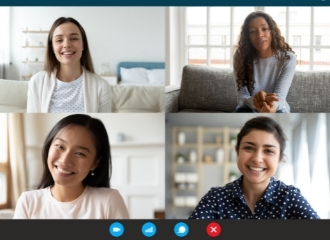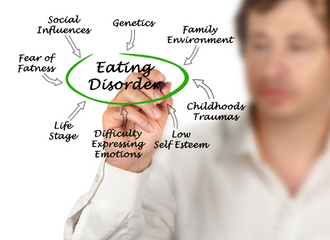Written by: Megan McIntire, LCMHC
Professional Relations Regional Manager, The Renfrew Center
Virtual eating disorder treatment offers a convenient and accessible platform for patients to receive care, with programming options ranging from Day Treatment (PHP), Intensive Outpatient (IOP) and Outpatient groups.

Since the COVID-19 outbreak began, many treatment providers have been at capacity, unable to take new patients due to the steep increase of individuals struggling with mental health concerns, the abrupt change in lifestyle and unique stressors the pandemic has created. For those who already struggle with isolation, these changes have amplified anxiety, depression and unhelpful strategies such as substance use and disordered eating.
Many treatment centers have shifted to virtual treatment, both as a measure to keep staff and patients safe from COVID, and to meet the increasing need for higher levels of care. Virtual treatment services have significantly expanded over the past year, allowing individuals to seek help who might not have otherwise had access to care due to distance or other barriers.
What is Virtual Eating Disorder Treatment and How Does it Work?

During virtual treatment, patients log-on using HIPAA-compliant software. Much like in-person care, the first step is for a prospective patient to call and schedule an assessment. During the assessment, which is a 1–2-hour virtual meeting, the clinical assessor works with the individual to determine what level of care best fits their needs. Once the assessment and medical clearance are completed, the patient can begin treatment.
What is the Patient Experience Like for Virtual Treatment?
On their first day, a new patient will complete an orientation where a clinician explains the structure and philosophy of the program, as well as the logistics and expectations for participation. The patient is then provided with a secure log-in to join virtual sessions. Much like a Zoom call, patients can see and communicate with one another as well as the facilitator. In addition to group sessions, patients engage in individual therapy, nutrition therapy, expressive therapies, psychiatric evaluation and follow up, medication management (if needed), psychoeducation, and supported meals.
What Are the Goals of Virtual Treatment?

Families may also engage in treatment through virtual family sessions and family support groups, where participants learn how to best support their loved one through recovery. Family therapy focuses on improving communication, increasing empathy, gaining clarity on eating disorders, and allows families to practice the emotion regulation skills their loved one is learning in treatment.
How Long Does Virtual Treatment Last?
Depending on the severity of the symptoms, how long a patient has been struggling and if they are experiencing medical complications as a result of their eating disorders, they may be recommended for Residential, Day Treatment (aka partial-hospitalization or PHP), or Intensive Outpatient (IOP). Patients typically attend Day Treatment for 4-6 weeks, and IOP for 6-8 weeks. Once the program is completed, it is recommended that patients continue to have weekly sessions with their outpatient team, as well as engage in a weekly aftercare group. Because eating disorders thrive in isolation, it is important for individuals to maintain support for long-term recovery.
Top 3 Benefits Virtual Treatment
- Accessibility
For many individuals who need a higher level of care, in-person treatment may not be available within a reasonable distance of their home. Virtual treatment has created the opportunity for those struggling with an eating disorder to engage in treatment for the first time. Additionally, for those who are stepping down from Residential care, they are now more likely to be able to stay within the same treatment program for the Day Treatment and Intensive Outpatient phases of recovery, leading to stronger continuity of care.
- Connection
Many eating disorder treatment centers offer specialized “tracks” to tailor programming to individual needs such as trauma, adolescent programming, substance use, etc. While a single treatment center may not have enough patients to run a specialized group, virtual treatment can allow individuals to network with others within the treatment center, as well as other locations, creating extensive opportunities for deeper connection. - Comfort
Entering treatment is a big step and can feel intimidating. Virtual treatment can soften the initial discomfort by allowing patients to engage from the comfort of their home. Patients still experience meal support, and prepping meals in their own kitchen gives them practice using the skills in the environment where they will be recovering.
How Do You Know if Virtual Treatment is Right for You?

Conclusion
Eating disorder treatment is becoming increasingly accessible through virtual programming options. Virtual treatment is HIPAA-compliant and utilizes experienced clinicians to provide patients with expert care in the comfort of their own home.
 For many individuals who need a higher level of care, in-person treatment may not be available within a reasonable distance of their home. Virtual treatment has created the opportunity for those struggling with an eating disorder to engage in treatment for the first time. Additionally, for those who are stepping down from
For many individuals who need a higher level of care, in-person treatment may not be available within a reasonable distance of their home. Virtual treatment has created the opportunity for those struggling with an eating disorder to engage in treatment for the first time. Additionally, for those who are stepping down from 

